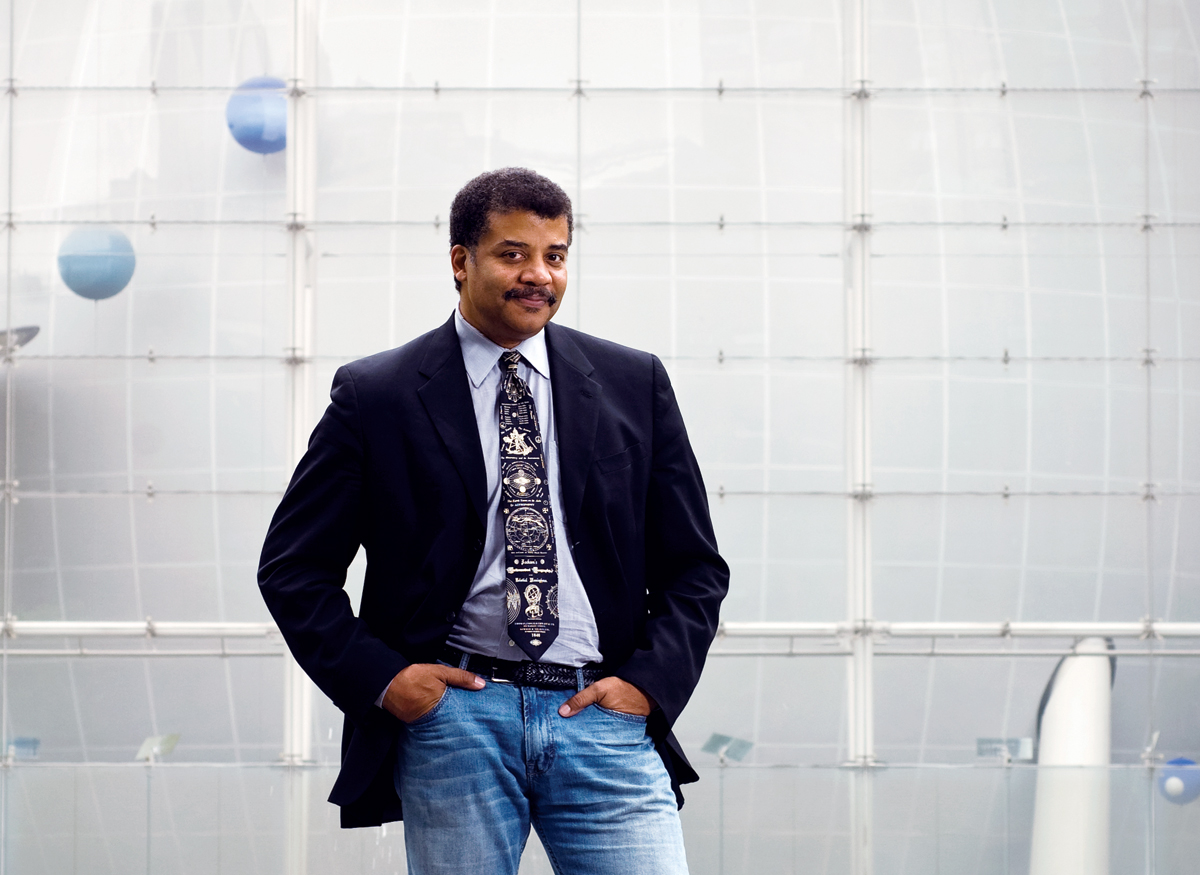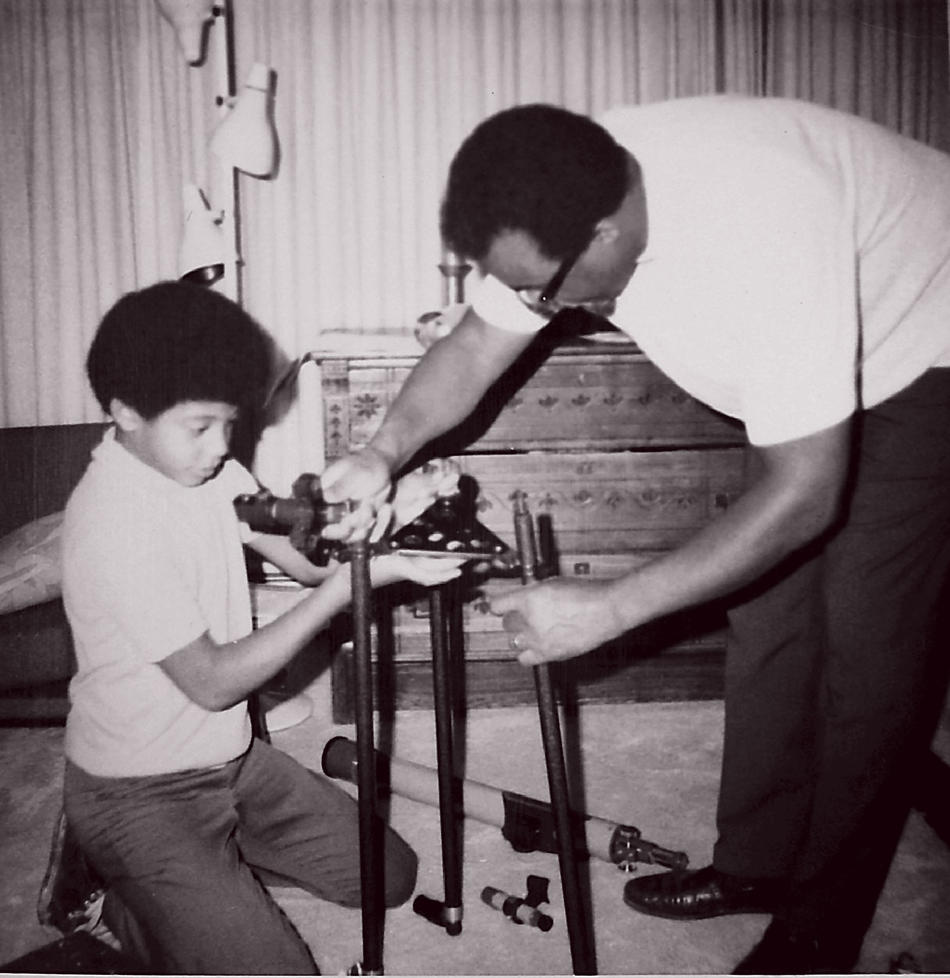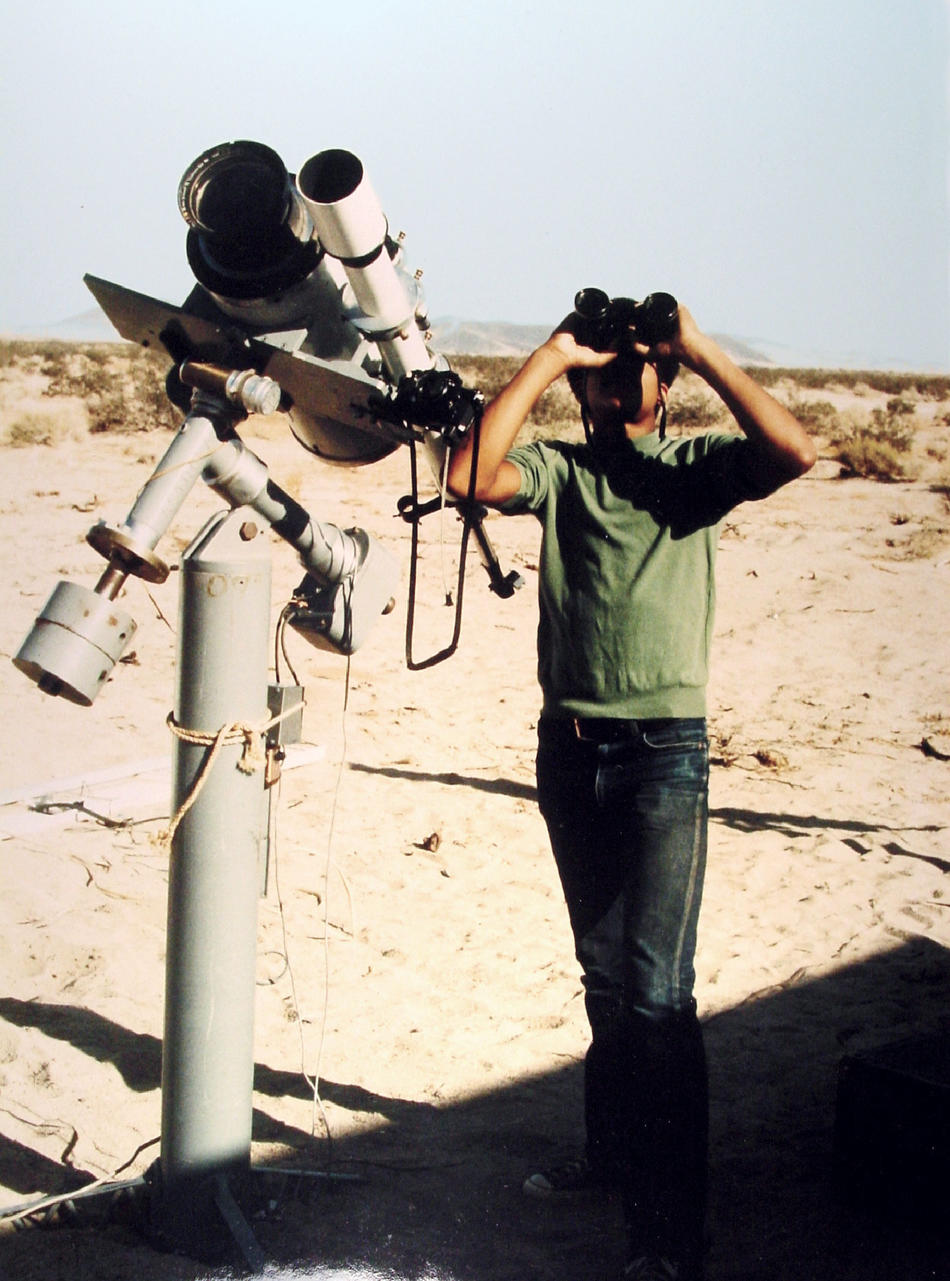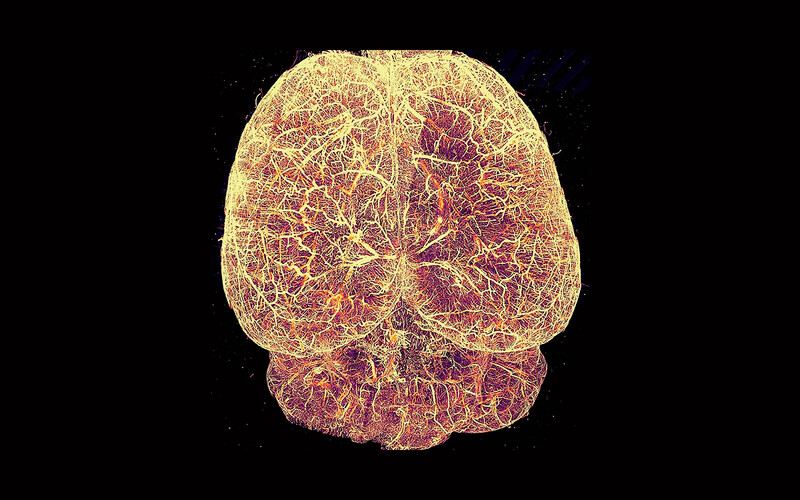
It’s the size of the Rose Bowl,” says Neil deGrasse Tyson in his blunt, personable way. “It’s going to be the biggest, closest object to pass by Earth in our recorded history.”
Tyson ’92GSAS is seated in his exuberantly cluttered office at the American Museum of Natural History’s Hayden Planetarium, where he is director. Behind his desk hangs Van Gogh’s Starry Night. The shelves are crammed with globes, books, awards. The desk holds a collection of long, luxuriant quill pens of ostrich and vulture. On a chair rests a pillow adorned with suns and moons, and Tyson’s vest is similarly emblazoned.
“If it hits, it’ll create a tsunami that’ll wipe clean the West Coast of the United States.”
Tyson is talking about an asteroid that astronomers named Apophis. In Egyptian mythology, he notes, Apophis is the god of death.
“This asteroid could do a trillion dollars’ worth of damage to the West Coast,” Tyson says, with a missionary spark. “People want to know about it, and I’m happy to tell them.” Frequently, Tyson tells them through the medium of late-night TV, where he performs the important, often funny, occasionally awkward, always fascinating service of conveying the high concepts of astrophysics in terms intelligible to Jay Leno. As he recently explained on The Tonight Show — and maybe a comedic atmosphere is the best place for material this heavy — Apophis will, on April 13, 2029 (“a Friday,” Tyson adds with twinkling portent), give our planet a “buzz cut,” dipping below our communication satellites. At that point, should the asteroid’s orbit thread the center of a 600-meter-wide zone called a keyhole, we’ll have to fund a project to deflect the thing — or else seven years later, when Apophis returns, it’s sayonara, Santa Monica.
“These are little facts that anyone is going to be interested in, even if you’ve never cared about science in your life,” Tyson says. “If you’re not interested, you don’t have a pulse. So talking about things like asteroids becomes a very effective means of getting a person to think about the universe, and to understand that Earth is not some island, isolated from cosmic forces.”
Tyson wants us to look up. He wants to empower us by communicating ideas about the machinery of the universe — not the names of the stars, or the order of the planets, but truths about the natural world as revealed by the laws of physics. To that end, he has published nine books (including a memoir, The Sky Is Not the Limit, and the best-selling Death by Black Hole) and written scores of essays on science and culture for the museum’s journal Natural History. He hosts the PBS program NOVA science NOW, and often materializes in less-rarefied sectors of the tube, from CNN to Comedy Central. There he is on CBS’s The Early Show, explaining Jupiter’s knack for attracting comets (it has more gravity than all the planets combined), or there, on The Daily Show, comforting Jon Stewart, who was shaken by Tyson’s matter-of-fact report that the expanding universe will scatter the galaxies so far apart into the cold depths of space that all processes will eventually “come to a rest.” And then, before you can say Copernicus, he’s off to an academic lecture on black holes, or to serve on a presidential commission on space, as he did in 2001 and in 2004. Since last year, he’s hosted a weekly radio show called StarTalk, aimed at an audience outside of the orbit of NPR: His sidekick is Lynne Koplitz, a salty comedienne who did not major in physics, and StarTalk is one of the few programs where you’re liable to hear the words “quasar” and “breasts” in the same conversation. Which is to say, Tyson is taking astrophysics further into the public sphere than anyone since Carl Sagan — all while leading one of New York’s most cherished institutions.
Oh, and then there’s that little matter of Pluto. But we’ll get to Pluto.
Venus Is Burning
A reasonable person might ask: Given all the problems on Earth — war, hunger, poverty, disease, unemployment, et cetera — why should the federal government spend billions of dollars in space?
As a public scientist, Tyson hears the question a lot, and it tends to raise his atmospheric pressure.
“I would just ask you: How much do you think we’re spending up there? Here’s your tax dollar. How much? Ten cents on the dollar? Five cents? The answer is one half of one cent. That funds the space stations, the space shuttles, all the NASA centers, all the launches, the Hubble Space Telescope, the rovers on Mars. All of it. Half a penny. “So the question isn’t, Why are we spending money up there and not down here? The question is, If we pumped that half a cent back into the 99.5 percent of the budget, would the country be fundamentally different in the ways you want? Do you believe that?
“NASA should be counted as a force of nature. There is no greater stimulus of the public’s interest in science and technology than the ambitions that NASA places in front of the country.”
Sure, but why not put more of NASA’s money toward studying our own planet? Monitoring for earthquakes, volcanoes, climate change, that sort of thing?
“I don’t believe you can fully understand Earth if that’s the only planet you are studying. Global climate change did not become a subject until scientists studied the effects of the K-T boundary impact on Earth’s ecosystem that took out the dinosaurs. Sixty-five million years ago, the dinosaurs went away rather abruptly. There’s an asteroid impact crater off the Yucatan peninsula, 200 kilometers wide, associated with that event. It’s under the Gulf of Mexico, and was found by petroleum geologists in 1981. No one was thinking about local events affecting global climate at the time. So here you have an asteroid from space hitting Earth as the first occasion for anyone to think about global climate change.
“The point is, discovery doesn’t come from studying the one object. Give me 10 other objects, and compare and contrast them, and then I’ll know what this one is. Our understanding of global greenhouse comes from Venus. Venus has runaway greenhouse. It’s 900 degrees on Venus. Something bad happened on Venus.
“So it is naive and bordering on dangerous to believe that you only have to study Earth if you want to understand Earth and solve its problems. I would even call it irresponsible.”
Fun with Earthlings
The first time Neil Tyson saw the hotbed of stars pulsing in the dome of the sky theater at the Hayden Planetarium, he thought it was a hoax. “I’d seen the sky from the Bronx,” he says, “and it didn’t look like that.” From that moment he was, as he likes to say, “imprinted by the universe.” He was nine years old.
In 1970, for his 12th birthday, his parents gave him a telescope. The family lived in the Riverdale section of the Bronx, in an apartment complex with the auspicious name of Skyview. While the other kids played ball, Tyson would clamber up to the top of his own private 22-story observatory. “The roof of my building — that was my access to the cosmos. No matter the temperature, as long as the sky was clear, I was there. And while you can’t see many things with the naked eye in the city, the telescope brings you all the planets, the moon, and the sun, too, if you have the right filters.”
The year that Tyson got his telescope, the family sojourned in the Boston suburb of Lexington. Tyson’s father, Cyril deGrasse Tyson, was a sociologist who had served as a commissioner under New York mayor John Lindsay during the civil rights struggle, and had now received a one-year appointment as a fellow at the Kennedy School’s Institute of Politics at Harvard. The Lexington house had a backyard, and that was where Tyson, under a densely jeweled canopy, was able, each quiet night, to “snuggle with the universe.” During the day, he followed the spots on the sun as they made their 25-day trek.
The family returned to New York. Tyson attended Bronx Science, where he became captain of the wrestling team and editor in chief of the school’s prestigious Physical Science Journal. He also took courses in astrophysics at the Hayden Planetarium.
In the summer of 1973, Tyson got his first taste of another kind of star power. He was 14 and drifting on the coastal waters of northwest Africa aboard the S.S. Canberra, whose cargo of 2000 scientists and other skygazers had come to view the total eclipse of the sun. Present on this floating laboratory were astronauts Neil Armstrong and Scott Carpenter, Hayden director Mark Chartrand III, and sci-fi author and educator Isaac Asimov ’39GS, ’48GSAS. On the return voyage, Tyson, the youngest unaccompanied person on the ship, distinguished himself to these luminaries by winning a trivia contest that hinged on a question about Saturn. Later that summer, he spent a month in the Mojave Desert at Camp Uraniborg, an astronomy program codirected by Joseph Patterson, now a professor of astronomy at Columbia.
When it came time to look for universities, Tyson was given a personal tour of the lab at Cornell by one of his heroes, Carl Sagan, whom he often watched on The Tonight Show, sharing insights of the cosmos with Johnny Carson. Ithaca tugged, but in the end, Tyson chose Harvard, where he earned a bachelor’s degree in physics. He then entered the PhD program in astrophysics at the University of Texas, but, as Columbia astronomy department chair David Helfand says, “He wasn’t getting the intellectual support he needed. Joe Patterson came to me and said, ‘Look, I know this kid, I knew him as a high school student, he’s a remarkable person. He’s at Texas, and he’s struggling. Can we do something about this?’ So Neil and I met, and it was obvious he had certain talents.”
With Helfand’s assistance, Tyson transferred into the PhD program at Columbia in 1988. “The astrophysics group at Columbia had just been rejuvenated,” Tyson says. “There was an influx of money, and they were increasing the faculty and participating in telescope projects.” The telescope that Tyson used was located at the Cerro Tololo Inter-American Observatory, 7000 feet above sea level in the Andes Mountains. It was there that Tyson conducted his doctoral research into the structure of the Milky Way. Back in the putative center of the universe, New York, Tyson’s fusion of scientific knowledge and personal dynamism came into alignment with opportunity: He received a NASA research fellowship, published four research papers and two popular-science books, attended four international conferences, appeared twice on network TV, and was appointed to a postdoctoral research position at Princeton.
On May 14, 1991, Tyson’s Columbia career was at its apex. That day, having been nominated for the honor by David Helfand, Tyson delivered the keynote address at the Graduate School of Arts and Sciences PhD Convocation in St. Paul’s Chapel. He arrived at St. Paul’s after a long flight from the observatory in Chile. “My inspiration for this address,” he told the crowd, “actually came from a mountaintop.”
Tyson has called it the most important speech of his life. In it, he spoke of his early aspirations of becoming an astrophysicist and “the shattering awareness that there were few parts of society that were prepared to accept my dreams. I wanted to do with my life what people of my skin color were not supposed to do.”
He spoke of unprovoked police stops, of being followed by guards in department stores, of being seen by society as a likely criminal whose athletic skills were genetic and whose academic successes were unearned. “Ladies and gentlemen,” he said, “to spend most of my life fighting these attitudes levies an emotional tax that is a form of intellectual emasculation. It is a tax that I would not wish upon my enemies. As of this afternoon, my PhD will bring the national total of black astrophysicists from six to seven. Given what I’ve experienced, I am surprised there are that many.”
He concluded by saying, “It is remarkable what can be accomplished when you are surrounded by people who believe in you; people whose expectations are not set by the shortsighted attitudes of society; people who help to open doors of opportunity, not close them. Thanks to Columbia’s interest in me, the love and support of my family, and the endorsement of the Department of Astronomy, I have truly lived and fulfilled a dream. Yet I know my life has just begun.”
Helfand recalls the reaction. “There wasn’t a dry eye in the house,” he says. “Jonathan Cole was provost at the time, and after the speech, he leaned over to me and said, ‘When do we hire him back?’”
Code Red
As Orson Welles portrayed it in his 1938 radio play, Mars wasn’t named after the Roman god of war for nothing. The War of the Worlds set back attitudes toward Martians by light years. Today, as the rovers Spirit and Opportunity explore the red planet, with its dried riverbeds and intriguing evidence of methane gas, Neil Tyson, filling Leno’s guest chair in a brown suit and galaxy-spattered tie, offers a twist on the Martian narrative. It’s possible, he says, that before life evolved on Earth, an asteroid slammed into a fertile Mars, flinging hunks of microbe-harboring rock into space. Some of those rocks could have landed on ourcooling planet, seeding it with life in a process called panspermia. “Maybe,” he says, “we’re all descended from Martians.”
“I’d like to get drunk with you,” says the guest to Tyson’s right, comedian Jimmy Fallon, who later, when told of Apophis’s grim approach, slumps in his seat, toking an imaginary joint. “You’re freaking me out, man!”
We can laugh, but Tyson is serious about the threats to Earth from “up there,” and sadistic space aliens don’t top the list. “Mars once had running water, and today it’s bone dry,” he says. “Something bad happened on Mars.” With Venus and Mars as our shining examples of planetary catastrophe, we ought to be on a technological war footing, Tyson believes. He points out that the moon landing in 1969 was the product not of a pure thirst for discovery, but of Cold War gamesmanship; that the species is driven less by curiosity than by survival in the face of existential threats. And as someone who survived an attack we didn’t see coming — Tyson was living a few blocks from the Twin Towers on September 11, 2001, and saw the laws of physics play out in the collision of objects and in human bodies falling as his binoculars darkened with the powder that blanketed downtown, gray and barren as lunar dust — his call for action against the Apophises of the world carries extra weight.
“I don’t want to be the laughingstock of the galaxy,” he says, “when they find out that a species that had the intelligence to stop an asteroid impact simply went extinct.”
Ice Fishing on Europa
In January 1610, Galileo Galilei, a 46-year old professor of mathematics at the University of Padua, aimed his newly made spyglass at the night sky. He saw awesome, astonishing things that he supposed might be best kept from an uneducated public. The moon was not a perfect sphere, as church doctrine taught, but had craters and mountains. Venus went through phases like the moon. The sun had spots. Saturn looked — peculiar. And Jupiter had four satellites of its own that wandered around it as the moon circles Earth — hardly a blessing for the geocentrists in Rome.
When Neil Tyson, on a Bronx rooftop, first gazed into the mists of the Milky Way, he “communed with Galileo across time and space,” as he recounts in his memoir, marveling that his own discoveries of the craggy lunar surface and of Jupiter’s smaller pirouetting partners were “as fresh for me in the Bronx, New York, as they must have been for Galileo in Florence, Italy, four centuries ago.” Galileo would be famously persecuted out of the human frailties of fear, ignorance, and vanity, and Tyson, traveling his “path of most resistance,” as he has described his life’s journey, knows as well as any astronomer that humans still have some distance to go. In his 100th essay for Natural History, in 2007, Tyson called for the embrace of “the cosmic perspective” — a humble, spiritual, nonreligious, open-minded consciousness gained from the study of the universe, one that exalts us and lifts us above our egos and lowly prejudices. “Imagine a world in which everyone, but especially people with power and influence, holds an expanded view of our place in the cosmos,” he wrote. “With that perspective, our problems would shrink — or never arise at all."
Today, in America, science literacy rates are low and calls for budget cuts are loud. Tyson warns that the nation is losing ground in science and technology “just by standing still.” He has a to-do list for the space program that he says will stimulate “intellectual capital.” Among other things, he wants to explore Jupiter’s moon Europa, first seen by Galileo 400 years ago. Scientists believe that Europa contains liquid water. “We should drill through the kilometers of ice on Europa and explore its subsurface liquid ocean for living organisms,” Tyson asserts.
For Tyson, the more evidence that we’re not the center of the universe, but part of a cosmic chain, the more connected we’ll feel to the cosmos and to each other. As he often tells audiences, we are, after all, made of stardust: The most prevalent chemically active elements of the universe — hydrogen, oxygen, carbon, and nitrogen — are the most common elements of life on Earth. “We are not simply in the universe,” he says, with cosmic profundity. “The universe is in us.”
Saturn’s Harvest
The final trivia question on the S.S. Canberra was this: Other than its beautiful rings, what feature strongly distinguishes Saturn from the other planets in the solar system?
The young Tyson was in his comfort zone. The year before, when asked to build a wooden lamp in his seventh-grade shop class, he ignored the basic design provided by the teacher and instead fashioned a clever instrument in the shape of his favorite planet: Saturn. You turned the lamp on and off by tilting its rings. Saturn was his. And so he knew, that night on the high seas, that Saturn is the only planet with a density less than that of water. Find a bowl big enough, and Saturn would float.
Tyson still has the Saturn lamp. It sits on his desk, among his quills and inkpots, a reminder of how the heavens inspire invention, and how those inventions illuminate our everyday lives — one of Tyson’s principal themes.
“They give out grants to medical researchers to find cures,” he says. “And the question becomes, ‘What about the physicists? Are we going to fund them, too?’ ‘Oh no, the days of the physicist are over, they built bombs for us.’ Excuse me, let’s pause for a minute. Yes, physicists were the scientific foundation of the military armament of the Cold War. But the last time you walked into a hospital, what were those machines with the on/off switches that can investigate the condition of your body without cutting you open? Those would be the X-ray machines, the MRI, and ultrasound. And every single one of them exists based on the principles of physics, discovered by a physicist who had no particular interest in medicine. Period.
“True revolutionary advances in our understanding of the natural world issue from the cross-pollination of disciplines. And the problems posed in the investigation of the universe attract people who have the smarts, the ambition, and the perseverance to make the discoveries that will transform the way we live.”
Father of the Sky
It was 1994, and the Hayden Planetarium was in trouble. Attendance was down. Many of the exhibits were outmoded. That year, Tyson, still a postdoc at Princeton, was hired by the Hayden as a half-time staff scientist, and asked to lead the effort to rebuild an institution that opened in 1935.
“I understood that the old facility was not serving the current generation,” Tyson says. “It was a planetarium dome with corridors that had mostly flat-panel exhibits, and that was basically it. The facility was good at showing the night sky, but now we know about black holes and quasars and colliding galaxies. There are more places to explore than just the night sky as seen from Earth.”
But if Tyson was going to help conceptualize the new $230 million Rose Center for Earth and Space, he had a precondition. “I said, ‘One thing we have to do is build a research department.’ And they said, ‘Oh, we don’t have time for that now, we just want to get this off the ground.’ ‘Well, then you’re not serious about it. Call me when you’re serious.’ And in 1996 came the full offer for me to become director, once the institution committed to building a research department for astrophysics.”
It took two years to vet architects and designers and look at plans and ideas, says Tyson. The new structure, which opened in February 2000 on the footprint of the old planetarium, is a sevenstory glass cube that houses the 87-foot-diameter, 4-million-pound Hayden Sphere. Inside the sphere is the Space Theater, where a Zeiss Mark IX star projector floods the vault with a throbbing night sky.
But Tyson takes most pride in the growth of the research department. “We went from one scientist, me, to 18 PhD scientists,” he says. “They’re doing research on the birth, life, and death of stars, the evolution of gas clouds within the galaxy, binary stars and their evolution, stars that might one day explode and what effect it would have on their environments, and the detection of planets orbiting around other stars.” Three of the researchers — Michael Shara, Ben Oppenheimer ’94CC, and Mordecai-Mark Mac Low — have full-time permanent adjunct positions at Columbia.
In 2004, Tyson stopped teaching at Princeton, going, as he says, “from a classroom of 200 to a classroom of 1 million.” Via TV satellites high above Earth, Tyson’s message is being carried around the planet.
“Neil is one of the great public spokesman for science and particularly for astrophysics,” says Ellen Futter ’71BC, ’74LAW, the former Barnard president who became director of the American Museum of Natural History in 1993. “He’s just a master at making a place that most people can’t see, and have difficulty imagining, come alive and be visible, not only in the sense that they’re seeing what it is or might be, but that they’re conceptualizing it intellectually. He makes the concepts accessible, and he relates them to us and to life on Earth.”
Now, in the Rose Center’s 10th year, Tyson is revisiting the exhibits to see what needs updating, modification, or reprioritizing. “Most of the exhibits here are idea-based rather than object-based,” he says. “It’s all too easy to talk about things. It’s much harder to talk about ideas. But ideas are what empower you.”
Ideas also can be divisive. One of Tyson’s decisions for the new facility, which involved an adjustment to the planetary displays, brought some unexpected shock waves: Tyson, the messenger, found himself in the center of a firestorm that spread from U.S. elementary schools to the outer limits of our solar system.
Neptunian Blues and Plutonic Love
Jon Stewart probably captured the feelings of a lot of Americans on a recent airing of The Daily Show, when he interrupted Tyson’s litany of reasons for doing what he’d done. Stewart’s face scrunched up in a mask of a child’s aggrieved sense of fairness; he jabbed an accusing finger at his guest and said, choking back a sob, “What did Pluto ever do to you?”
Neil Tyson isn’t cowed by these appeals. “Pluto had it coming,” he told Stewart and the rest of America. No one ever accused an astrophysicist of being sentimental.
In his office, Tyson recalls the morning of January 22, 2001, when the New York Times ran a headline on the front page that said: “Pluto No Longer a Planet? Only in New York.” It seemed that a Times journalist had discovered, a year after the Rose Center opened, that something was missing from the Hayden’s exhibits of the solar system. That was because the science committee for the Rose Center’s design and construction, headed by Tyson, had decided to classify the major objects of the solar system by like properties: the four terrestrial planets, the four gas giants, and — well, Pluto seemed to have more in common with the countless icy objects out in the Kuiper Belt. And wouldn’t Pluto be happier lumped with its brethren, instead of being a planetary oddball?
“If Pluto were as close to the sun as the Earth is,” says Tyson, “heat from the sun would evaporate Pluto’s ice and it would grow a tail. We’ve got words for tailed objects in the universe. We call them comets.”
This bit of scientific reasoning didn’t stop Tyson from receiving hate mail in crayon from third graders, who, like Stewart, couldn’t understand why their cute little planet, which shared a name with a Disney dog, should be kicked off the planetary playground.
“It’s love,” says Tyson. “There’s no other way to interpret what happened except that people are connected in a visceral way to Pluto as a planet. I was surprised by the intensity with which people expressed their emotions over what we had done.”
With all the angry letters and phone calls, Tyson could hardly focus on his work. For catharsis, he wrote a book called The Pluto Files: The Rise and Fall of America’s Favorite Planet. A PBS program based on the book aired this past March, starring the telegenic Tyson, who guides us through Pluto’s phases, from its discovery in 1930 at the Lowell Observatory in Flagstaff, Arizona, by astronomer Clyde Tombaugh (the same year, as it happened, that a certain lovable dog debuted in the Disney animated short The Chain Gang), to the decision in 2006 by the International Astronomical Union to reclassify Pluto as a dwarf planet — six years after Tyson and the Hayden had gone where no planetarium had gone before.
Pluto’s demotion (or admission, if you prefer) to the belt of icy objects ringing the solar system does have a significant impact on at least one other planet: Neptune, named after Pluto’s mythological brother, has been pushed to the end of the line. That’s a tough pill to swallow for a gas giant with two moons. But Neptune, like Pluto before it, might do well to heed some wisdom from Tyson himself. The words appear as an epigraph to Tyson’s memoir:
Beyond the judgment of others
Rising high above the sky
Lies the power of ambition.
Oh, and Pluto — if you see Apophis out there, tell him we’ve got enough problems.



